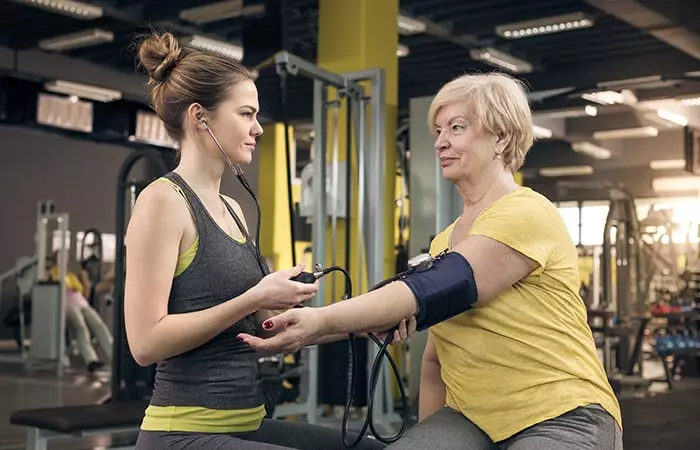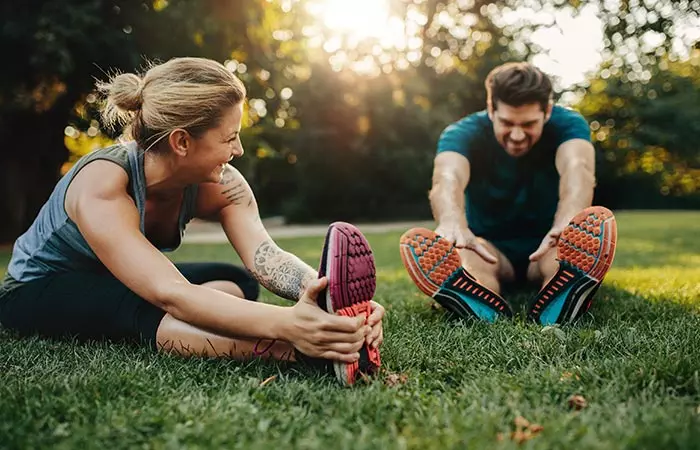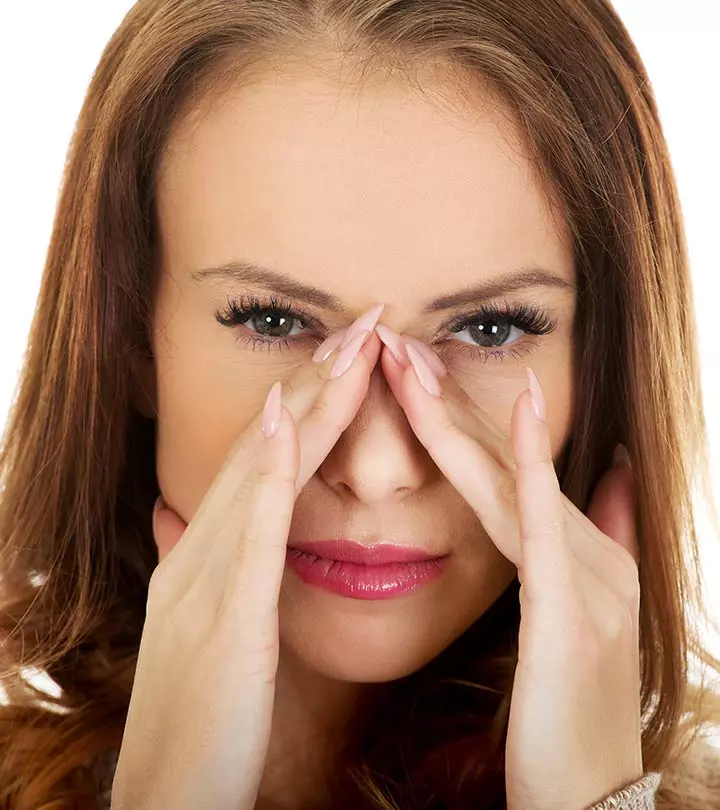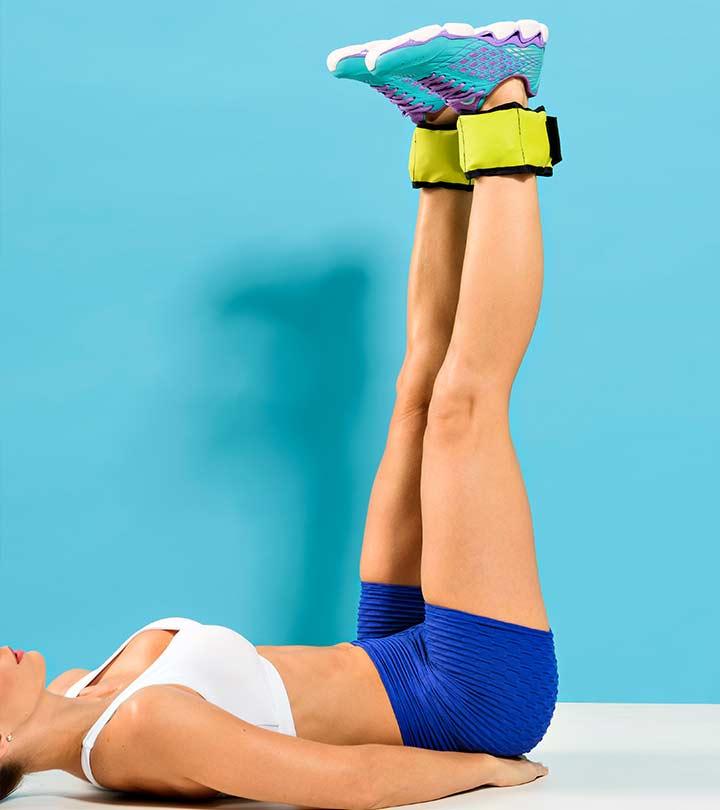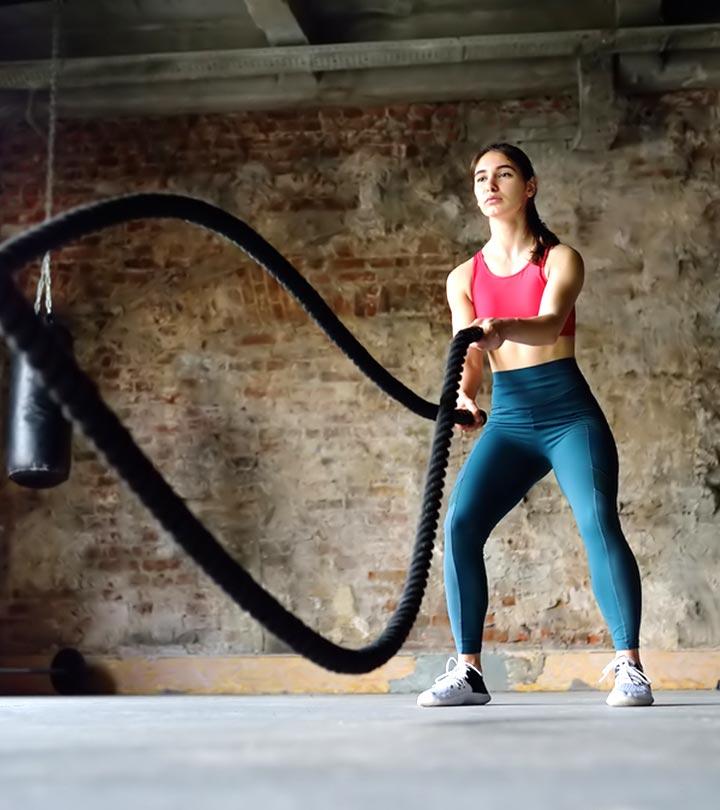Changes In Blood Pressure After Exercise – Should You Worry?
Update yourself about hypertension and the exercises you can try or avoid.

Image: Shutterstock
Research shows that exercising helps lower blood pressure (1), (2). But if you measure your blood pressure before, during, and after exercising, you will notice that blood pressure does not remain stagnant. So, what really happens to blood pressure? Does it increase or decrease? If you have high or low blood pressure, should you be exercising? Are there any alternate, safer exercises? Scroll down to learn about what experts recommend.
In This Article
What Is Normal Blood Pressure?
According to the American Heart Association (AHA), normal or healthy blood pressure is less than 120 (systolic) Hg mm and less than 80 (diastolic) Hg mm (also written as 120/80 Hg mm). A systolic blood pressure of 120-129 Hg mm is considered elevated blood pressure. Above 130/80 is considered hypertension (3).
To understand these numbers better, it is best to know what systolic and diastolic blood pressure are:
- Systolic BP: Indicates how much pressure your blood is exerting against your artery walls when the heart beats.
- Diastolic BP: Indicates how much pressure your blood is exerting against your artery walls while the heart is resting between beats.
Systolic blood pressure is of more importance when it comes to diseases and health conditions. Aging, lack of physical activity and a poor lifestyle can cause the arteries to become stiff, which increases the systolic blood pressure and leads to hypertension and cardiovascular diseases (3). Now, let’s find out what happens to your systolic and diastolic blood pressure during and after exercising. Scroll down.
 Did You Know?
Did You Know?What Happens To Your Blood Pressure After Exercise?
Matt Scarfo, a NASM-certified CPT-OPT, CES, PES, FNS, says, “Exercise causes a person’s blood pressure to elevate while it is happening. This is because while you are working out, your muscles are contracting in order to pump blood back to your heart, leading to an elevated BP.” Certified personal trainer and fitness coach Robert Dodds points out, “Exercise will cause systolic blood pressure to rise acutely (during exercise) but the long-term effects of exercise may help to lower blood pressure.” This means exercising may cause blood pressure to rise temporarily. But it helps maintain the normal blood pressure of 120/80 Hg mm for people with hypertension. But what happens post-exercise? How long does your blood pressure or pulse rate remain elevated? Find out below.
In a study published in Hypertension, the blood pressure at maximum physical effort during exercise was established using treadmill cardiopulmonary exercise testing in the US. Here, the maximum systolic blood pressure percentiles for women were calculated for each decade. Women’s peak diastolic blood pressure increased consistently over each decade. For further information, see the graph below.
Peak Systolic Blood Pressure Responses During Exercising
Source: Peak Blood Pressure Responses During Maximum Cardiopulmonary Exercise TestingHow Long Does It Take For Your BP To Return To Normal?
Dodds confirms, “Blood pressure should stay elevated for around 2 hours after exercise, so it’s important to wait at least this long. So, to understand and compare your blood pressure readings, check your blood pressure before starting to exercise. Check your BP again during exercise and, finally, take a reading two to three hours after exercise. You will see a spike in your blood pressure during exercise. However, it will come back to normal levels after 2-3 hours.
You may think that since exercising increases blood pressure, it might not be safe to exercise if someone has hypertension. That is why experts recommend only a few safe exercises for people with hypertension. What are they? Scroll down to find out.
Safe Exercises For People With Hypertension
“Although it depends on the individual and you should always consult your doctor, most people with high blood pressure are perfectly capable of safely performing exercises such as running, cycling, swimming, or weight training as long as they make a conscious effort not to overexert themselves and to stop if they start feeling nauseous or lightheaded,” advises Scarfo. “For these reasons, it is a good idea to stick with light to moderate intensity workouts rather than heavy ones until you have a better idea of what your body can handle,” he says. In other words, you may do the following endurance exercises if you have high blood pressure:
- Walking
- Jogging
- Cycling
- Moderate-paced swimming
- Weight training with light weights
- Resistance band exercises with light resistance
Shivangi Singh, a lifestyle blogger, recounts how she managed her blood pressure levels by making minor changes in her diet and lifestyle. She made brisk walking, swimming, or cycling a part of her routine. She writes, “Regular exercise helped me maintain a healthy weight, reduce stress, and improve cardiovascular health (i).”
Are there any exercises you need to avoid if you have hypertension? Check out the following section to know more.
 Did You Know?
Did You Know?Exercises To Avoid If You Have Hypertension
“Riskier activities are anything done at a high intensity such as weights lifted at near 100% effort, sprinting, etc. Skydiving, scuba diving, and other extreme sports should also be avoided. Sports like squash, tennis, football, basketball, etc., are a gray area. It depends on how intensely the person is participating – e.g., whether they are sprinting and maximally exerting themselves,” warns Dodds. So, here’s a list of exercises to avoid:
- Sprinting
- High-intensity workouts
- Heavy weight lifting
- Strength training with heavyweights
- Outdoor sports
- Adventure sports
Keep these points in mind but beware that exercising may also lower your blood pressure. Get the full picture in the following section.
Can Exercising Cause Low Blood Pressure?
In one study, scientists found that regardless of the type of exercise, it showed a dip in blood pressure during (hypotensive effect) and after exercise (6). Why does that happen? When exercising, the muscles contract and pump the blood back to your heart. The cardiac output is lowered after the exercise as blood moves to areas where there is less blood, leaving the heart low on blood as well, thus decreasing the blood pressure (7).
Dodds also throws some light in this regard: “Blood may pool in muscles, particularly farther away from the heart (in the extremities) during/after exercise. When diastolic blood pressure is low, it is harder for the blood to return to the heart between beats. This can cause a decline in cardiac output which results in lower blood pressure. This is more common with people who have low blood pressure (hypotension) generally. If you feel lightheaded during exercise or like you are going to pass out, this could be because of a reduction in blood pressure.” He adds, “Orthostatic hypotension may be more likely. This occurs when moving from a seated or lying position to a standing position. It may be more likely to happen for people with low blood pressure during certain types of exercise.”
Whether you have high or low blood pressure, you must take a few precautions if you want to exercise without passing out. Here are a few pointers.
Safety Precautions To Take
The American Heart Association recommends taking the following tips to reduce your risk of injury (8).
- Always do a 10-minute warm-up before you work out.
- Tone down the intensity of your exercises.
- Make sure that you avoid oily foods before or after working out.
- Compression socks may be useful in preventing blood from pooling in the lower legs and keeping more of it in the upper body to maintain your blood pressure.
Infographic: Exercises to Perform and Avoid If You Have Hypertension
Although hypertension is the most prevalent and expensive risk factor for cardiovascular disease, it may be greatly avoided by making healthy lifestyle modifications. To prevent, treat, and manage high blood pressure, exercise is typically suggested as the first form of lifestyle therapy. Regular mild exercise can help lower your blood pressure and, as a result, promote cardiovascular health.
Knowing which workouts to do and which to avoid is essential for those with hypertension to prevent unneeded difficulties. Check out the infographic below to learn more! Illustration: StyleCraze Design Team
The Final Takeaway
Exercising is essential to stay fit and healthy. However, exercising can either increase or decrease blood pressure from normal levels. It is best to talk to your doctor if you have a history of high or low blood pressure to understand which exercises would be safe for you to do. Also, do a little test to see if your blood pressure increases or decreases during exercise and how long it takes for it to come back to normal levels. Take the necessary precautions to prevent any unwanted outcomes due to changes in blood pressure after exercise.
Frequently Asked Questions
Can BP patients do planks?
Yes, planks, wall sits, and yoga can be beneficial for people with high blood pressure.
Are jumping jacks good for high blood pressure?
Yes, jumping jacks are a cardio workout that helps increase blood circulation and regulates blood pressure.
For how long is blood pressure elevated after exercise?
It can take a few hours after exercising for your blood pressure to return to normal. It is recommended to wait for at least 30 minutes before you check your blood pressure after exercise.
Key Takeaways
- Systolic BP indicates how much pressure your blood exerts against artery walls when the heart beats.
- Exercising may cause BP to rise temporarily, but it helps maintain the normal BP in hypertension.
- Walking, jogging, cycling, moderate-paced swimming are safe exercises for people with hypertension.
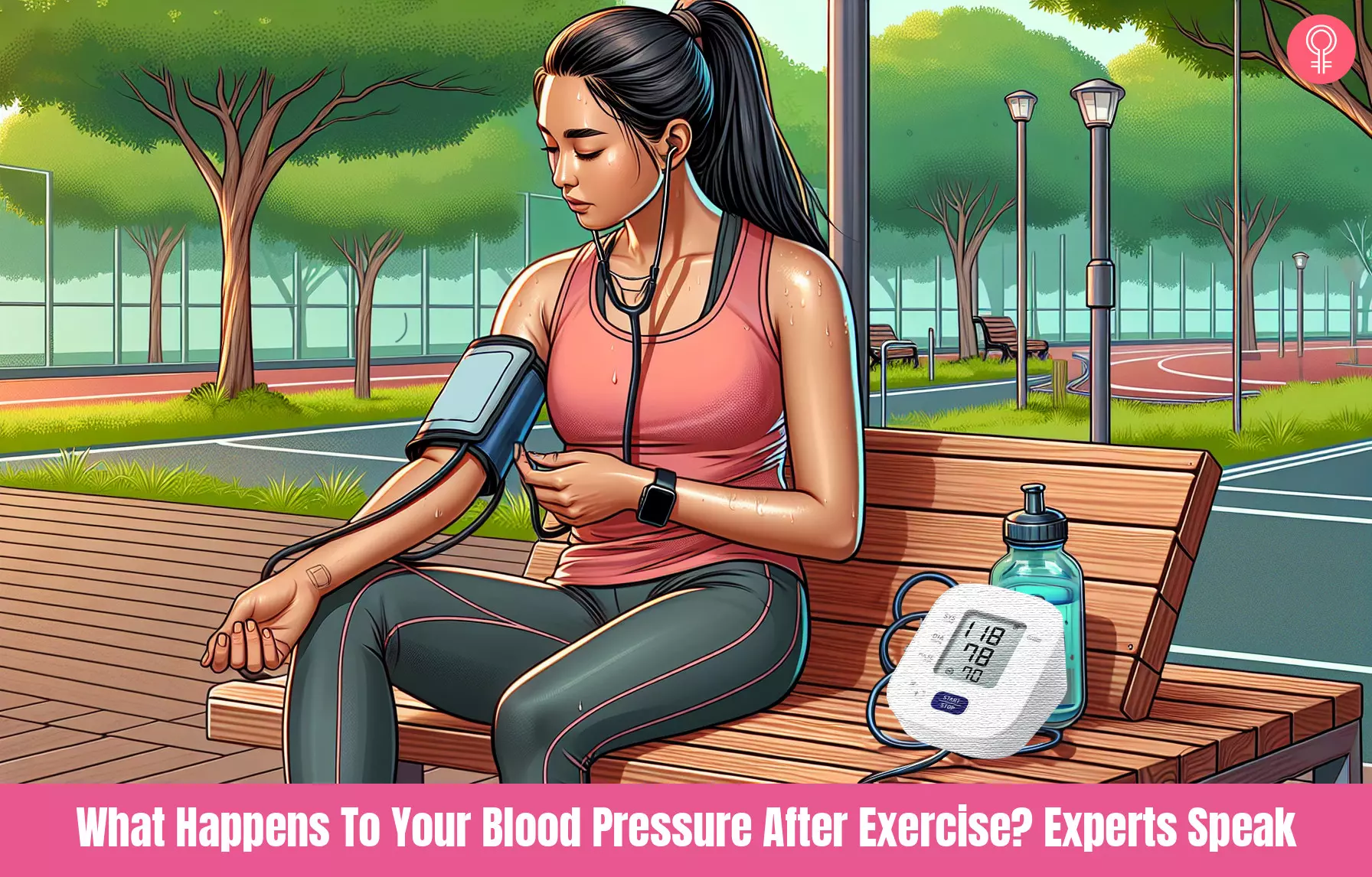
Image: Dall·E/StyleCraze Design Team
Decode the vital relationship between blood pressure and exercise in this informative video below. Gain insights into how physical activity can positively impact your cardiovascular health. So, go ahead and check it out now!
Personal Experience: Source
StyleCraze's articles are interwoven with authentic personal narratives that provide depth and resonance to our content. Below are the sources of the personal accounts referenced in this article.
i. My Small Journey with High Blood Pressurehttps://medium.com/@sshivangi537/my-small-journey-with-high-blood-pressure-ec90bfa763d5
References
Articles on StyleCraze are backed by verified information from peer-reviewed and academic research papers, reputed organizations, research institutions, and medical associations to ensure accuracy and relevance. Read our editorial policy to learn more.
- Exercise as a tool for hypertension and resistant hypertension management: current insights
https://www.ncbi.nlm.nih.gov/labs/pmc/articles/PMC6159802/ - Evidence for exercise training in the management of hypertension in adults
https://www.ncbi.nlm.nih.gov/labs/pmc/articles/PMC4369613/ - Understanding Blood Pressure Readings
https://www.heart.org/en/health-topics/high-blood-pressure/understanding-blood-pressure-readings - Hypertensive Crisis
https://www.sciencedirect.com/topics/medicine-and-dentistry/hypertensive-crisis - Influence of Physical Activity on Hypertension and Cardiac Structure and Function
https://www.ncbi.nlm.nih.gov/pmc/articles/PMC4624627/ - Acute Effects of Exercise on Blood Pressure: A Meta-Analytic Investigation
https://www.ncbi.nlm.nih.gov/labs/pmc/articles/PMC4914008/ - Potential causes mechanisms and implications of post exercise hypotension
https://idp.nature.com/authorize?response_type=cookie&client_id=grover&redirect_uri=https%3A%2F%2Fwww.nature.com%2Farticles%2F1001377 - Getting Active to Control High Blood Pressure
https://www.heart.org/en/health-topics/high-blood-pressure/changes-you-can-make-to-manage-high-blood-pressure/getting-active-to-control-high-blood-pressure - Athletes and Hypertension
https://www.ncbi.nlm.nih.gov/pmc/articles/PMC8520516/
Read full bio of Nilofar Pendhari
Read full bio of Ravi Teja Tadimalla
Read full bio of Payal Karnik






